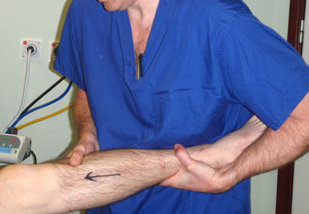The pivot shift test is a test to assess the integrity of both the anterior cruciate ligament and and also the other key structures that contribute to the knee's stability.
 Page updated April 2024 by Dr Sheila Strover (Clinical Editor)
Page updated April 2024 by Dr Sheila Strover (Clinical Editor)

The pivot shift test is best performed under anaesthesia.
How to perform the pivot shift test
The patient lies face up with the head supported.
The examiner stands to the side of the knee, grasping the the ankle in one hand with the heel of the other hand behind the fibula head, with the hip flexed to 30 degrees and maintaining 20 degrees of internal tibial rotation. It is important to abduct the hip a bit to relax the iliotibial band.
The examiner slowly flexes the knee, while slowly increasing internal rotation and adding a valgus force. The test is positive when the tibia suddenly subluxes.
The test is very subjective, and it takes experience to interpret confidently.
Pivot shift and the anterolateral ligament
The pivot shift test was originally conceived to identify anterior cruciate ligament laxity.
But there is also a strong correlation between the more severe gradings on the pivot shift test and grade II and II injuries of the anterolateral ligament.
-
Quote from peer-reviewed paper:
"The pivot shift phenomenon is multifactorial. With growing evidence that meniscal, meniscocapsular, and [anterolateral complex] injury may play a role in rotatory knee instability, it is important for the clinician to be aware of concomitant soft tissue injuries with planned ACL reconstruction procedures."
Citation: Vaudreuil NJ, Rothrauff BB, de Sa D, Musahl V. The Pivot Shift: Current Experimental Methodology and Clinical Utility for Anterior Cruciate Ligament Rupture and Associated Injury. Curr Rev Musculoskelet Med. 2019 Mar;12(1):41-49. doi: 10.1007/s12178-019-09529-7. PMID: 30706283; PMCID: PMC6388573.
Anterolateral rotatory instability - what does that mean?
The medical explanation for the pivot shift test is that it is assessing anterolateral rotatory instability.
What that means is that it is testing for two things - the potential of the tibia to slip forwards in relation to the femur because of a cruciate ligament insufficiency, and also the potential of the tibia to rotate internally in relation to the femur because of an anterolateral ligament insufficiency.
The importance of identifying the rotational component is that in the past many anterior cruciate ligament reconstructions failed because the important contribution of the anterolateral ligament to knee joint stability was not appreciated.